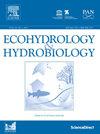Modeling changes in nutrient retention ecosystem service using the InVEST-NDR model: A case study in the Gumara River of Lake Tana Basin, Ethiopia
IF 2.2
4区 环境科学与生态学
Q2 ECOLOGY
引用次数: 0
Abstract
Aquatic ecosystems provide valuable ecosystem services (e.g., habitat for fisheries) to surrounding communities but environmental degradation can diminish the quality of these ecosystem services. The Lake Tana basin, including the Gumara River and its associated wetlands in Ethiopia, has experienced rapid environmental change in the last several decades. Changes in the export of nutrients from the uplands might contribute to the rapid degradation of aquatic ecosystem services due to the expansion of water hyacinths and declines in fish biodiversity and yields. We estimate how human modification and climate change have impacted watershed nutrient retention from 1986 to 2020. Here we (1) examine trends in surface water chemistry, watershed land use/land cover change, and flow alterations; (2) estimate the watershed nutrient delivery ratio (NDR), a metric of watershed nutrient retention, through time; and (3) examine how fishery yields and water hyacinth infestation in Lake Tana at the outlet of the Gumara River change during a period of rapid increase in nutrient export from the Gumara River. Estimates of the surface load and export of both phosphorus (P) and nitrogen (N) from the Gumara River watershed were approximately stable between 1986 and 2009, but from 2014 to 2020 exports increased by 69 % for P and 80 % for N. Potential factors driving this rapid increase include an expansion in irrigation for agriculture, land conversion to eucalyptus plantations, decreases in dry season flow, and an increase in mean annual precipitation since 2009. In addition, the increase in nutrient export from the Gumara River watershed coincides with a near extirpation of fish in the Gumara River and a ten-fold expansion of water hyacinth downstream in Lake Tana. Human activity and hydrological alteration in the Gumara River watershed have resulted in water quality changes, declines in fish populations, and the expansion of invasive species. Long-term monitoring and watershed modeling can help inform the management of regionally important aquatic ecosystems such as the Gumara River and Lake Tana.
利用InVEST-NDR模型模拟营养保持生态系统服务变化:以埃塞俄比亚塔纳湖流域古马拉河为例
水生生态系统为周围社区提供有价值的生态系统服务(如渔业栖息地),但环境退化会降低这些生态系统服务的质量。塔纳湖流域,包括古马拉河及其在埃塞俄比亚的相关湿地,在过去的几十年里经历了快速的环境变化。由于水葫芦的扩张和鱼类生物多样性和产量的下降,从高地输出营养物质的变化可能会导致水生生态系统服务的迅速退化。我们估算了1986年至2020年人类活动和气候变化对流域养分保留的影响。在这里,我们(1)研究了地表水化学、流域土地利用/土地覆盖变化和流量变化的趋势;(2)估算流域养分输送比(NDR)随时间的变化,NDR是流域养分保留的度量;(3)考察古马拉河出水口塔纳湖的渔业产量和水葫芦侵染在古马拉河养分出口快速增加期间的变化。1986年至2009年,古马拉河流域磷和氮的地表负荷和出口量大致稳定,但从2014年到2020年,磷和氮的出口量分别增加了69%和80%。驱动这一快速增长的潜在因素包括农业灌溉的扩大、土地转向桉树人工林、旱季流量的减少以及2009年以来平均年降水量的增加。此外,古马拉河流域营养物出口增加的同时,古马拉河的鱼类几乎灭绝,塔纳湖下游的水葫芦数量增加了10倍。古马拉河流域的人类活动和水文变化导致水质变化、鱼类种群减少和入侵物种扩大。长期监测和流域建模有助于为古马拉河和塔纳湖等区域重要水生生态系统的管理提供信息。
本文章由计算机程序翻译,如有差异,请以英文原文为准。
求助全文
约1分钟内获得全文
求助全文
来源期刊

Ecohydrology & Hydrobiology
Agricultural and Biological Sciences-Aquatic Science
CiteScore
5.40
自引率
3.80%
发文量
51
期刊介绍:
Ecohydrology & Hydrobiology is an international journal that aims to advance ecohydrology as the study of the interplay between ecological and hydrological processes from molecular to river basin scales, and to promote its implementation as an integrative management tool to harmonize societal needs with biosphere potential.
 求助内容:
求助内容: 应助结果提醒方式:
应助结果提醒方式:


